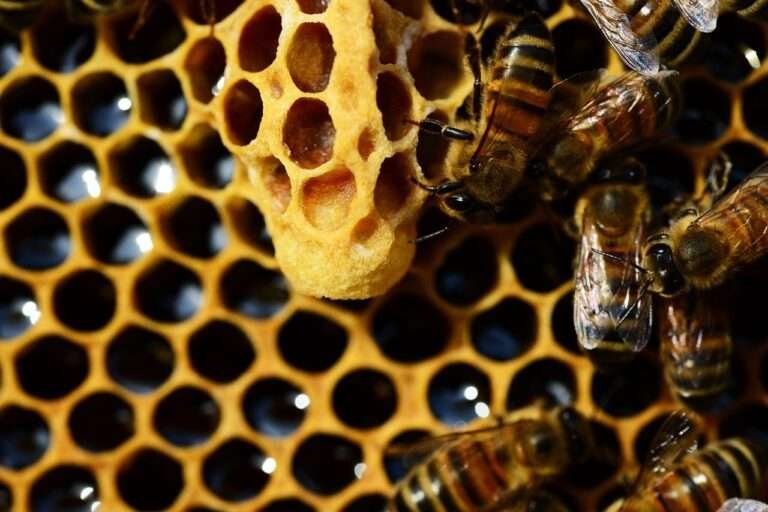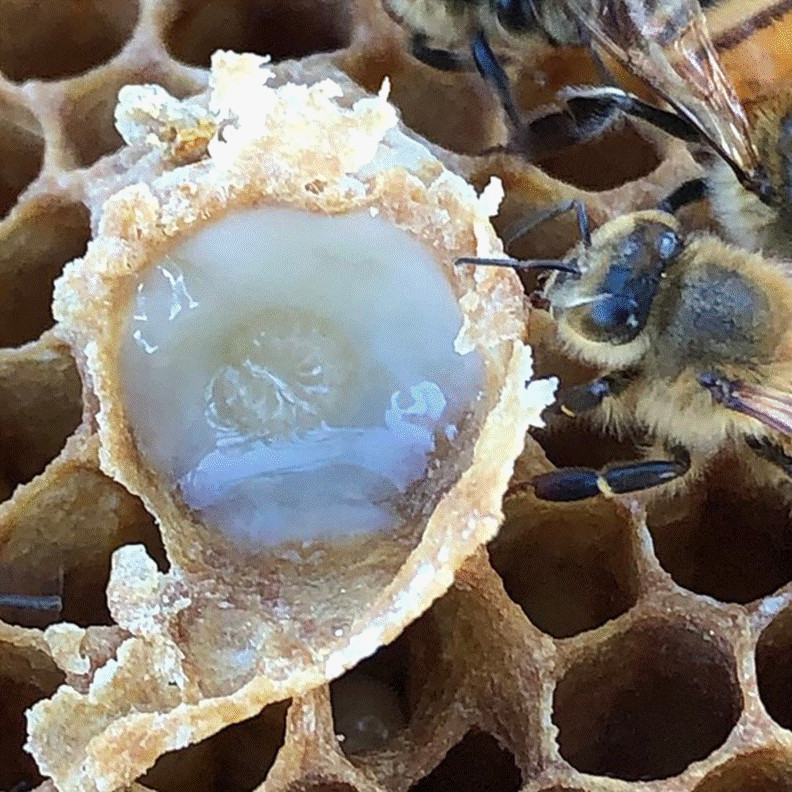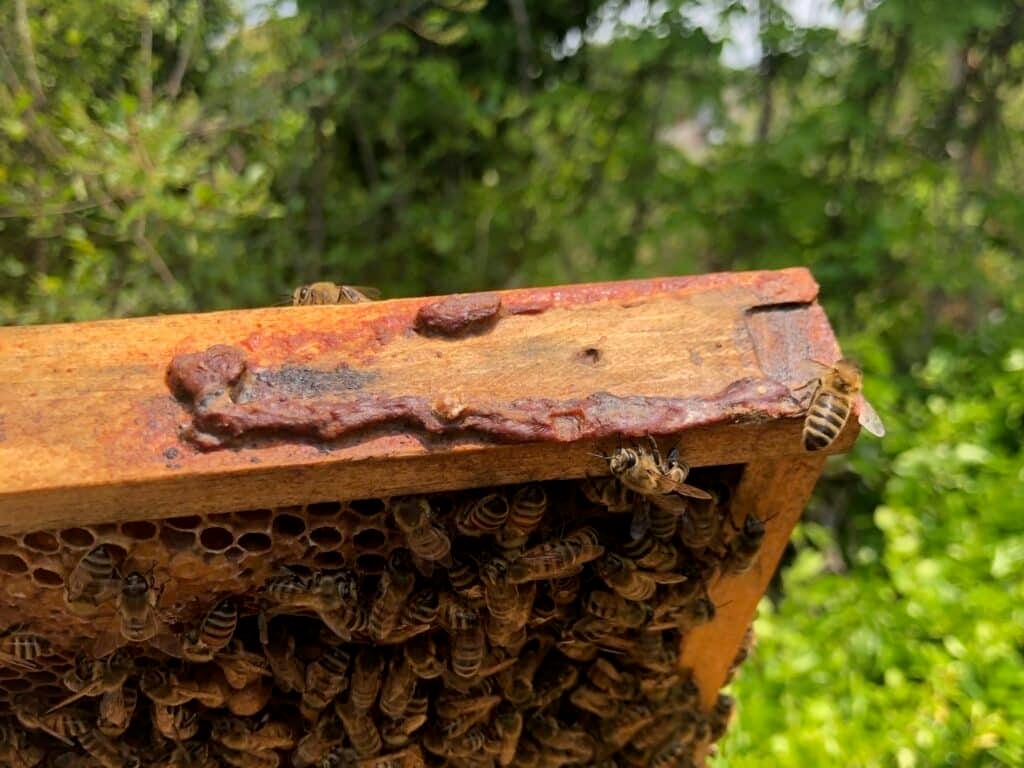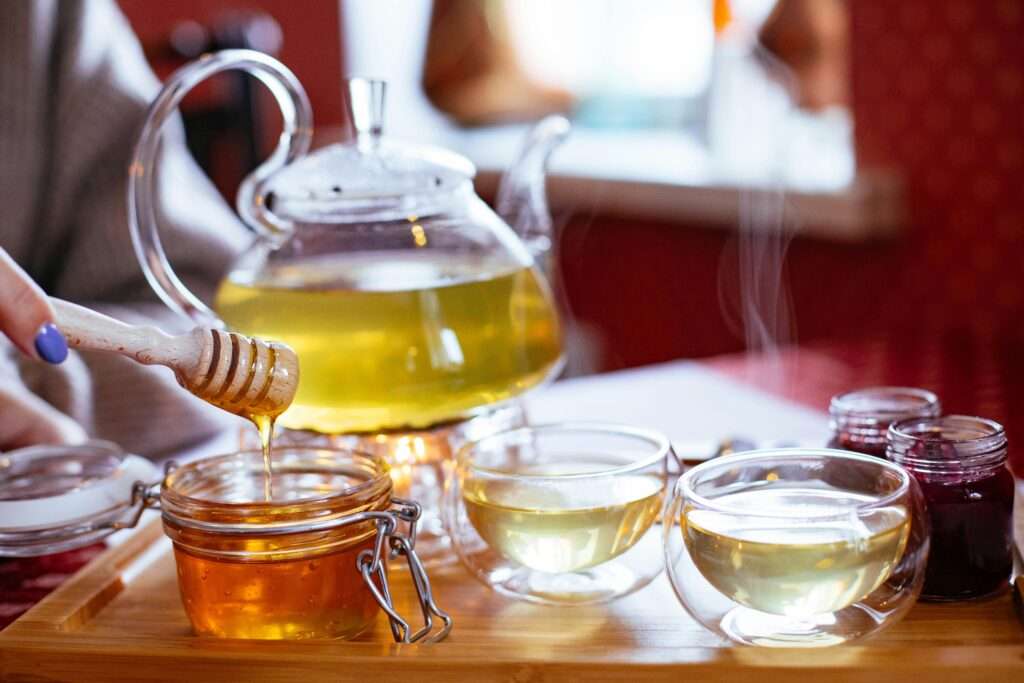Royal jelly is a remarkable, nutrient-dense substance produced by honeybees that has captured human attention for its extraordinary properties and potential health benefits.
This pale, creamy secretion serves as the exclusive diet of queen bees and plays a crucial role in honeybee colony hierarchy while offering various applications for human health and wellness.
Two queen bee cells containing royal jelly and larvae inside a beehive’s honeycomb structure
What is Royal Jelly?
Royal jelly is a creamy, white to pale yellow gelatinous substance secreted by the hypopharyngeal and mandibular glands of young worker bees (nurse bees) between 5-15 days old.
Often referred to as “honey bee milk” or “bee’s version of mother’s milk,” this protein-rich secretion has a distinctive sour, slightly bitter taste and a consistency similar to condensed milk.[1][2][3]
The substance gets its royal designation from its primary purpose: feeding queen bees. While all larvae receive royal jelly for the first 2-3 days of development, only developing queens continue to consume it exclusively throughout their larval stage and adult life.
This exclusive diet is what transforms an ordinary larva into a queen bee, enabling her remarkable longevity of 3-5 years compared to worker bees’ 6-week lifespan.[3][4][1]
Composition and Nutritional Profile
Royal jelly has a complex chemical composition that varies depending on geographic origin, season, and colony conditions. The typical composition includes:[3][5][6]
- Water: 50-70%
- Proteins: 9-18% (including Major Royal Jelly Proteins – MRJPs)
- Carbohydrates: 7-18% (primarily fructose and glucose)
- Lipids: 3-8% (including unique fatty acids)
- Minerals: 0.8-3%
- Vitamins, amino acids, and other compounds: Small amounts
Key Bioactive Components
10-Hydroxy-2-decenoic acid (10-HDA) is perhaps the most significant compound in royal jelly, comprising about 3.5% of its content. This unique fatty acid, also called “queen bee acid,” is found exclusively in royal jelly and nowhere else in nature. 10-HDA is responsible for many of royal jelly’s therapeutic properties, including antimicrobial, anti-inflammatory, and potential anti-cancer effects.[3][7][8]
Major Royal Jelly Proteins (MRJPs) are a family of glycoproteins that contribute to the substance’s beneficial properties. These proteins, particularly royalactin, play crucial roles in queen bee development and may offer health benefits to humans.[9][10]
Vitamins and Minerals
Royal jelly is particularly rich in B-complex vitamins:[5][9]
- Thiamine (B1)
- Riboflavin (B2)
- Niacin (B3)
- Pantothenic acid (B5) – especially abundant at 52.8 mg/100g
- Pyridoxine (B6)
- Biotin (B7)
- Folic acid (B9)
The mineral content includes potassium (261.9-362.0 mg/100g), phosphorus, calcium, magnesium, and trace amounts of iron, zinc, copper, and manganese.[11]
Close-up of a honeycomb cell containing royal jelly with bees nearby
Production and Harvesting
Natural Production Process
Royal jelly production is a sophisticated biological process involving nurse bees consuming pollen to activate their hypopharyngeal glands. The quality and quantity of royal jelly depend heavily on the pollen available to nurse bees, with larvae “swimming” in pools of jelly when adequate pollen is present.[1]
Commercial Production Methods
Commercial royal jelly production employs two main approaches:[12]
Discontinuous Method: The queen is removed from the colony, and artificial queen cells containing larvae are introduced. Frames are exchanged every 3 days for harvesting, with production breaks needed after 3-4 harvests.[12]
Continuous Method: A nucleus containing the queen and part of the colony is placed near the main colony, allowing permanent production throughout the bee season by regularly exchanging combs.[12]
Harvesting Process
Royal jelly harvesting requires precision and sterile conditions. The process involves:[13][14]
- Timing: Optimal harvesting occurs 72 hours after larval grafting when quality peaks[12]
- Larval Removal: Carefully extracting larvae from queen cells using fine tweezers[14]
- Collection: Using spatulas or suction devices to gather the jelly[14]
- Filtration: Removing impurities through fine mesh sieves[14]
- Storage: Immediate refrigeration at 0-5°C in airtight containers[14]
China produces over 90% of global royal jelly (approximately 4,000 tons annually) using specialized high-producing honeybee strains.[15]
Benefits to Bees
Queen Development and Longevity
Royal jelly’s primary biological function is creating and sustaining queen bees. The exclusive royal jelly diet triggers dramatic physiological changes:[4]
- Size: Queens develop 40% larger than worker bees
- Reproduction: Fully developed ovaries enabling egg-laying (up to 2,000 eggs daily)
- Lifespan: Extended from 6 weeks (workers) to 3-5 years (queens)[4]
Colony Health and Stability
Royal jelly contributes to overall colony health by:
- Ensuring reproductive capacity through queen maintenance
- Supporting larval development during critical early stages
- Maintaining colony hierarchy and social structure
- Providing antimicrobial protection due to its antibacterial properties[8]
Immune System Support
The antimicrobial properties of royal jelly, particularly from 10-HDA, help protect developing larvae and the queen from bacterial and fungal infections. This natural defense mechanism is crucial for colony survival.[8]
Benefits to Humans

Bottle of freeze-dried royal jelly capsules by Y.S. Organic Bee Farms, each 2,000 mg and equivalent to fresh state royal jelly.
Scientifically Supported Benefits
Menopause Symptom Relief: Multiple studies show royal jelly can help alleviate menopausal symptoms, including hot flashes and vaginal dryness. A 2011 study found significant improvement when royal jelly was combined with other natural ingredients.[16][17]
Cholesterol Management: Research indicates royal jelly may help improve cholesterol profiles in healthy postmenopausal women when taken at 150mg daily for 3 months.[16]
Anti-inflammatory Effects: 10-HDA demonstrates significant anti-inflammatory properties by reducing pro-inflammatory cytokines (TNF-α, IL-1β, IL-8) and increasing anti-inflammatory factors.[8]
Wound Healing: Studies suggest royal jelly may accelerate wound healing through its regenerative properties and growth-promoting factors.[10][16]
Potential Therapeutic Applications
Neuroprotective Properties: Animal studies indicate royal jelly and 10-HDA may protect against stroke-related brain damage and support cognitive function.[10][18]
Antimicrobial Activity: 10-HDA shows potent antibacterial effects against various pathogens, including Staphylococcus aureus, E. coli, and Salmonella.[8]
Blood Sugar Management: Some research suggests royal jelly may help regulate blood glucose levels, though more human studies are needed.[17]
Skin Health: The combination of proteins, vitamins, and antioxidants in royal jelly supports skin regeneration and may have anti-aging effects.[19][20]
Cosmetic and Beauty Applications
Royal jelly is widely used in skincare products for its:
- Moisturizing properties due to lipid content
- Anti-aging effects from antioxidants and collagen-promoting amino acids
- Skin healing benefits through growth factors and peptides[19]
Safety Considerations and Side Effects
Common Side Effects
While generally safe for most people, royal jelly can cause:[17][21]
- Abdominal pain and upset stomach
- Skin rash or irritation
- Cough and respiratory symptoms
- In rare cases, bloody stool
Serious Allergic Reactions
The most significant risk is allergic reactions, particularly in individuals with:[21][22][23]
- Existing bee product allergies
- Asthma or atopic conditions
- Pollen allergies
Severe reactions can include anaphylaxis, throat swelling, and breathing difficulties, requiring immediate medical attention.[17][21]
Drug Interactions
Royal jelly may interact with:[17]
- Blood thinners (warfarin) – increasing bleeding risk
- Blood pressure medications – potentially lowering blood pressure excessively
- Diabetes medications – affecting blood sugar levels
Contraindications
Royal jelly is not recommended for:[17][21]
- Pregnant or breastfeeding women
- Children under certain ages (consult healthcare providers)
- Individuals with severe allergies to bee products
- People with dermatitis (may worsen condition)
Commercial Forms and Quality Considerations
Available Forms
Royal jelly is commercially available as:[24]
- Fresh/raw royal jelly – requires refrigeration, highest potency
- Freeze-dried capsules – stable, standardized dosing
- Liquid extracts – often combined with honey or other ingredients
- Cosmetic formulations – creams, serums, and skincare products
Quality and Standardization Concerns
The royal jelly market faces significant quality control challenges:[17]
- No international quality standards (except Chinese national standards)
- Unregulated supplement industry in many countries
- Varying concentrations of active compounds (especially 10-HDA)
- Potential adulteration or contamination
Choosing Quality Products
When selecting royal jelly products, look for:[17]
- Third-party testing and certification
- Standardized 10-HDA content (typically 1.4-2.0%)
- Proper storage conditions and expiration dates
- Reputable manufacturers with quality control practices
Dosage and Usage Guidelines
Recommended Dosages
Research-based dosage recommendations vary by purpose:[22]
- General health: 50-100mg daily
- Cholesterol management: 150mg daily
- Menopause symptoms: Varies by formulation and combination products
Storage and Handling
Fresh royal jelly requires:[14]
- Refrigeration at 0-5°C
- Airtight containers to prevent oxidation
- Protection from light and moisture
- Short shelf life (weeks to months)
Processed forms are more stable but should still be stored in cool, dry conditions.
Future Research Directions
Current research continues to explore royal jelly’s therapeutic potential in:
- Cancer prevention and treatment through 10-HDA’s anti-tumor properties
- Neurodegenerative diseases including Alzheimer’s and Parkinson’s
- Metabolic disorders such as diabetes and obesity
- Wound healing applications in clinical settings
- Standardization and quality control methods for commercial products
Conclusion
Royal jelly represents a fascinating intersection of nature’s ingenuity and human health applications. For bees, it serves as the foundation of colony social structure, enabling queen development and maintaining reproductive capacity. For humans, it offers a complex array of bioactive compounds with demonstrated and potential therapeutic benefits.
While royal jelly shows promise for various health conditions, particularly menopause symptom relief and wound healing, consumers should approach it with informed caution. The risk of allergic reactions, potential drug interactions, and quality control issues in commercial products necessitate careful consideration and professional guidance.
As research continues to unravel the mechanisms behind royal jelly’s effects, this remarkable bee product may find expanded applications in medicine, cosmetics, and functional foods. However, the current evidence emphasizes the importance of quality sourcing, appropriate dosing, and awareness of individual risk factors when considering royal jelly supplementation.
The story of royal jelly ultimately demonstrates the remarkable sophistication of bee societies and their potential contributions to human health and wellness, bridging the gap between traditional apitherapy and modern scientific understanding.
⁂
- https://bestbees.com/royal-jelly/
- https://www.apicolturalaterza.it/gb/blog/how-bees-produce-royal-jelly-b94.html
- https://pmc.ncbi.nlm.nih.gov/articles/PMC11203284/
- https://www.amentsoc.org/insects/glossary/terms/royal-jelly/
- https://www.nature.com/articles/s41598-024-82094-3
- https://www.healthline.com/nutrition/royal-jelly
- https://en.wikipedia.org/wiki/Royal_jelly
- https://www.youtube.com/watch?v=TFlMtrfadS0
- https://pmc.ncbi.nlm.nih.gov/articles/PMC7915653/
- https://www.webmd.com/vitamins/ai/ingredientmono-503/royal-jelly
- https://pmc.ncbi.nlm.nih.gov/articles/PMC9568691/
- https://link.springer.com/article/10.1007/s13592-015-0374-x
- https://www.britannica.com/science/royal-jelly
- https://www.fao.org/4/w0076e/w0076e16.htm
- https://www.sciencedirect.com/science/article/pii/S1756464621001638
- https://www.merriam-webster.com/dictionary/royal jelly
- https://beeculture.com/royal-jelly-worker-bee-produced-protein-rich-mothers-milk/
- https://www.webmd.com/diet/royal-jelly-good-for-you
- https://www.sciencedirect.com/topics/agricultural-and-biological-sciences/royal-jelly
- https://www.reddit.com/r/explainlikeimfive/comments/vcoseh/eli5_how_do_bees_make_royal_jelly_and_how_does_it/
- https://www.rxlist.com/supplements/royal_jelly.htm
- https://www.medicalnewstoday.com/articles/324152
- https://www.health.com/royal-jelly-8380140
- https://beekeepclub.com/how-to-harvest-royal-jelly-beginners-guide/
Ad – Amazon Associate Store












